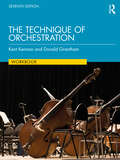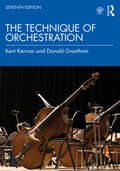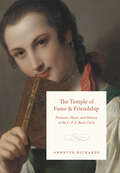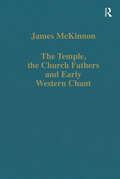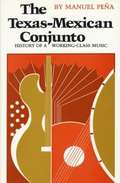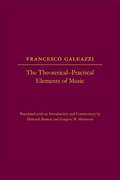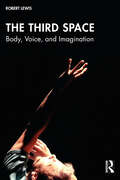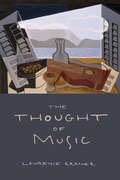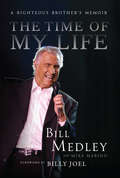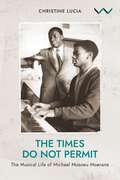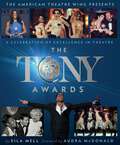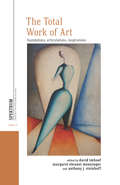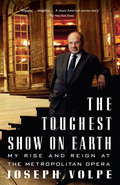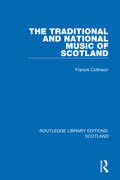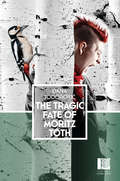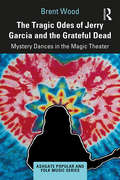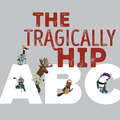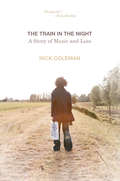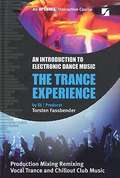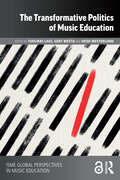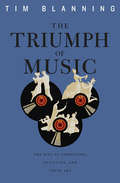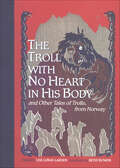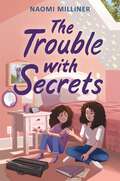- Table View
- List View
The Technique of Orchestration Workbook
by Kent Kennan Donald GranthamThe Technique of Orchestration Workbook, Seventh Edition, accompanies the textbook of the same name—the definitive resource on the study of orchestration—providing musical excerpts, full scores, and scoring assignments to enrich the lessons learned in the textbook. Spanning an array of periods and styles, the musical examples collected here cover scoring techniques in the following sections: Strings Woodwinds Brass Scoring of Chords Transcribing Piano Music Scoring for Woodwinds, Horns, and Strings Percussion Harp and Keyboard Instruments Scoring for Full Orchestra Additional learning tools include transposition exercises, error detection drills, and discussions on harmonics, while the workbook pages are perforated throughout for ease of use in and out of the classroom. Featuring the music of Bach, Mozart, Brahms, Beethoven, Schumann, Copland, Bartók, and many more, The Technique of Orchestration Workbook, Seventh Edition, is an invaluable companion to the textbook.
The Technique of Orchestration: Pearson New International Edition
by Kent Kennan Donald GranthamThe Technique of Orchestration, Seventh Edition, is the definitive textbook on the study of orchestration, offering a concise, straight-to-the-point approach that prepares students to score their own compositions with confidence. Updated to reflect developments in instruments and orchestral best practices, this seventh edition features: Copious musical examples spanning the history of the orchestra Detailed descriptions of instruments and their distinctive characteristics Explanations of how to score chords and transcribe piano idioms Discussions on specialized ensembles and scoring techniques New musical examples have been added throughout and listening lists have been revised to include more music by women and composers of color, representing a diverse musical catalogue. Supported by an accompanying workbook of scores and scoring exercises (available separately), as well as a robust listening program keyed to the textbook, The Technique of Orchestration, Seventh Edition, is an accessible, essential, all-in-one resource for the student of orchestration.
The Temple of Fame and Friendship: Portraits, Music, and History in the C. P. E. Bach Circle
by Annette RichardsThis book examines the renowned portrait collection assembled by C. P. E. Bach, J. S. Bach’s second son. One of the most celebrated German composers of the eighteenth century, C. P. E. Bach spent decades assembling an extensive portrait collection of some four hundred music-related items—from oil paintings to engraved prints. The collection was dispersed after Bach’s death in 1788, but with Annette Richards’s painstaking reconstruction, the portraits once again present a vivid panorama of music history and culture, reanimating the sensibility and humor of Bach’s time. Far more than a mere multitude of faces, Richards argues, the collection was a major part of the composer’s work that sought to establish music as an object of aesthetic, philosophical, and historical study. The Temple of Fame and Friendship brings C. P. E. Bach’s collection to life, giving readers a sense of what it was like for visitors to tour the portrait gallery and experience music in rooms thick with the faces of friends, colleagues, and forebears. She uses the collection to analyze the “portraitive” aspect of Bach’s music, engaging with the influential theories of Swiss physiognomist Johann Caspar Lavater. She also explores the collection as a mode of cultivating and preserving friendship, connecting this to the culture of remembrance that resonates in Bach’s domestic music. Richards shows how the new music historiography of the late eighteenth century, rich in anecdote, memoir, and verbal portrait, was deeply indebted to portrait collecting and its negotiation between presence and detachment, fact and feeling.
The Temple of Fame and Friendship: Portraits, Music, and History in the C. P. E. Bach Circle
by Annette RichardsThis book examines the renowned portrait collection assembled by C. P. E. Bach, J. S. Bach’s second son. One of the most celebrated German composers of the eighteenth century, C. P. E. Bach spent decades assembling an extensive portrait collection of some four hundred music-related items—from oil paintings to engraved prints. The collection was dispersed after Bach’s death in 1788, but with Annette Richards’s painstaking reconstruction, the portraits once again present a vivid panorama of music history and culture, reanimating the sensibility and humor of Bach’s time. Far more than a mere multitude of faces, Richards argues, the collection was a major part of the composer’s work that sought to establish music as an object of aesthetic, philosophical, and historical study. The Temple of Fame and Friendship brings C. P. E. Bach’s collection to life, giving readers a sense of what it was like for visitors to tour the portrait gallery and experience music in rooms thick with the faces of friends, colleagues, and forebears. She uses the collection to analyze the “portraitive” aspect of Bach’s music, engaging with the influential theories of Swiss physiognomist Johann Caspar Lavater. She also explores the collection as a mode of cultivating and preserving friendship, connecting this to the culture of remembrance that resonates in Bach’s domestic music. Richards shows how the new music historiography of the late eighteenth century, rich in anecdote, memoir, and verbal portrait, was deeply indebted to portrait collecting and its negotiation between presence and detachment, fact and feeling.
The Temple, the Church Fathers and Early Western Chant (Variorum Collected Studies)
by James McKinnonThe articles here deal with liturgical music. Two topics receive special attention: the curiously negative role that musical instruments play in ancient cult music and the development of ecclesiastical song in early Christianity. The first series of articles treats classical Greek ethical notions of instruments, the status of instruments in Temple and Synagogue, and the absence of instruments from early Christian and medieval church music. The next parts trace the psalmody and hymnody of the Christian tradition, from its roots in Judaism to the origins of Gregorian chant in 7th-century Rome. Throughout, the writings of the Christian Church fathers such as Augustine, Ambrose, Basil and John Chrysostom underpin the author’s analysis and presentation.
The Texas-Mexican Conjunto: History of a Working-Class Music
by Manuel H. PeñaA history of conjunto music and musicians.
The The Theoretical-Practical Elements of Music, Parts III and IV
by Deborah Burton Francesco Galeazzi Gregory W. HarwoodA virtuoso violinist, conductor, composer, and a professor of mathematics and botany, Francesco Galeazzi (1758–1819) firmly believed that musical education should be clear, demonstrable, and practical. In 1791 and 1796, he published the two volumes of his Elementi teorico-practici di musica, a treatise that demonstrated both his thorough grounding in the work of earlier theorists and his own approach to musical study. The first volume gave precise instructions on the violin and how to play it; the second demonstrated his command of other instruments and genres and provided comprehensive introductions to music theory, music history, and music aesthetics. The treatise also addresses the nature of compositional process and eighteenth-century concerns about natural and acquired talent and creativity. This volume offers an unprecedented English translation of the second volume of Elementi teorico-practici di musica, with annotations and commentary. The translation is introduced with a study of Galeazzi's life and milieu, the genesis and sources for the Elementi, and its reception through the present day.
The Theremin: Play, But Don't Touch (Fountas & Pinnell LLI Purple #Level V)
by Kathleen Krull Paul BrewerThe inventor of the theremin had a genius for electronics. The Russian government realized how useful his creativity could he and decided to have him invent spying devices.
The Third Space: Body, Voice, and Imagination
by Robert LewisThe Third Space serves a crucial need for contemporary performers by providing an interdisciplinary and physiovocal approach to training. It is a new take on body and voice integration designed to develop the holistic performer. It takes performers through a series of step-by-step practical physiovocal exercises that connects the actor’s centre to the outside world, which increases awareness of self and space. It also develops a deeper connection between spaces within the body and the environment by connecting sound, imagination, and movement.Robert Lewis’s approach is a way of working that unlocks the imagination as well as connecting performers to self, space, and imagination, through voice and body. It conditions, controls, and engages performers by integrating various voice and movement practices.The theories and practice are balanced throughout by: introducing the practical works theoretical underpinnings through research, related work, and case studies of performances; demonstrating a full program of exercises that helps performers get in touch with their centre, their space, and shape both within and outside the body; and exploring the performers physiovocal instrument and its connection with imagination, energies, and dynamics. This book is the result of nearly 20 years of research and practice working with voice and movement practitioners across the globe to develop training that produces performers that are physiovocally ready to work in theatre, screen, and emergent technologies.
The Thought of Music
by Lawrence KramerWhat, exactly, is knowledge of music? And what does it tell us about humanistic knowledge in general? The Thought of Music grapples directly with these fundamental questions--questions especially compelling at a time when humanistic knowledge is enmeshed in debates about its character and future. In this third volume in a trilogy on musical understanding that includes Interpreting Music and Expression and Truth, Lawrence Kramer seeks answers in both thought about music and thought in music--thinking in tones. He skillfully assesses musical scholarship in the aftermath of critical musicology and musical hermeneutics and in view of more recent concerns with embodiment, affect, and performance. This authoritative and timely work challenges the prevailing conceptions of every topic it addresses: language, context, and culture; pleasure and performance; and, through music, the foundations of understanding in the humanities.
The Time of My Life: A Righteous Brother's Memoir
by Bill Medley Mike Marino Foreword by Billy JoelFrom an early age, Bill Medley had a passion for music. School glee club and amateur singing contests soon gave way to the albums of Ray Charles and Little Richard. That raw R&B influence would profoundly shape Medley’s musical future. As the pioneering "blue-eyed soul” group the Righteous Brothers, Bill Medley and late partner Bobby Hatfield sang such huge hits as "(You’re My) Soul and Inspiration,” "Unchained Melody,” and "You’ve Lost That Lovin’ Feelin’,” the latter recognized by BMI as the most-played song of the twentieth century. Medley’s duet with Jennifer Warnes for the Dirty Dancing soundtrack, "(I’ve Had) the Time of My Life,” became a worldwide No. 1 single on its way to winning an Oscar, a Grammy, and a Golden Globe. But Medley’s story isn’t just about the hits and the awards. It’s about an immensely talented man who reached the pinnacle of fame, success, and excess, until the shocking murder of his wife, Karen. In time, this tragedy eventually helped him renew his commitment to both faith and family.
The Times Do Not Permit: The Musical Life of Michael Mosoeu Moerane
by Christine LuciaThis biography of Michael Mosoeu Moerane (1904-1980) surveys the unique life, times and music of the first classically educated African composer in southern Africa.
The Tony Awards: A Celebration of Excellence in Theatre
by Eila Mell The American Theatre WingCommemorating over 75 years of Broadway greatness with never-before told stories, rare photos from the American Theatre Wings' archives, and interviews with major honorees like Lin-Manuel Miranda, Patti LuPone, and Hugh Jackman, The Tony Awards is the official, authorized guide to Broadway's biggest night.The Tony Awards: A Celebration of Excellence in Theatre pays tribute to the magic that happens when the curtain goes up and Broadway's best and brightest step onto center stage. Supported by the American Theatre Wing, the arts organization that founded the Tony Awards in 1947 and continues to produce the Tony Awards live telecast each year, author Eila Mell has interviewed a cavalcade of past and present Tony winners, including actors, producers, writers, costume designers, and many many others. Their voices fill the pages of this book with fascinating, behind-the-scenes stories about what it's like to win the theatre world's highest honor. Featuring a foreword by Audra McDonald and over 400 color and black-and-white photographs, The Tony Awards also spotlights more than 130 captivating interviews with a parade of industry insiders, including: Mel Brooks, Matthew Broderick, Carol Burnett, Kristin Chenoweth, Glenn Close, James Corden, Bryan Cranston, Neil Patrick Harris, Jennifer Holliday, Hugh Jackman, John Kander, Angela Lansbury, Judith Light, Hal Linden, Kenny Leon, Patti LuPone, Lin-Manuel Miranda, Brian Stokes Mitchell, Rita Moreno, Bernadette Peters, Chita Rivera, Martin Short, Tom Stoppard, Julie Taymor, Leslie Uggams, and Sir Andrew Lloyd Webber.
The Total Work of Art: Foundations, Articulations, Inspirations (Spektrum: Publications of the German Studies Association #12)
by David Imhoof Margaret Eleanor MenningerFor two centuries, Gesamtkunstwerk-the ideal of the "total work of art"-has exerted a powerful influence over artistic discourse and practice, spurring new forms of collaboration and provoking debates over the political instrumentalization of art. Despite its popular conflation with the work of Richard Wagner, Gesamtkunstwerk's lineage and legacies extend well beyond German Romanticism, as this wide-ranging collection demonstrates. In eleven compact essays, scholars from a variety of disciplines trace the idea's evolution in German-speaking Europe, from its foundations in the early nineteenth century to its manifold articulations and reimaginings in the twentieth century and beyond, providing an uncommonly broad perspective on a distinctly modern cultural form.
The Toughest Show on Earth: My Rise and Reign at the Metropolitan Opera
by Joseph Volpe Charles MichenerA fascinating, anecdote-filled behind-the-scenes look at more than forty years of the highlights, successes, and day-to-day inner workings—all about productions, the divas, and backstage dramas—of New York’s Metropolitan Opera House, by Joseph Volpe, the only general manager to have risen through the ranks. This book is the story of Volpe’s years leading up to those at the Met, from his first job as a stagehand at the Morosco Theater to the odd jobs he picked up moonlighting: setting up a searchlight or laying down a red carpet for a movie premiere, changing titles on the marquees at the Astor, Victor, and Paramount theaters. It is his Met years—from apprentice carpenter to general manager—that give us a story about New York and the business of culture. Volpe looks at the Met today, an institution full of vast egos and complicated politics, as well as its glittering past—the old Met at Thirty-ninth and Broadway, and the political and artistic intrigues that exploded around its move to Lincoln Center. With stunning candor, he writes about the general managers he worked under, including Rudolf Bing and Anthony Bliss; his own embattled rise to the top; the maneuverings of the blue-chip board; his bad-cop, good-cop collaboration with the conductor James Levine; and his masterful approach to making a family of such highly charged artist-stars as Luciano Pavarotti, Placido Domingo, Teresa Stratas, and Renée Fleming, and such visionary directors as Franco Zeffirelli, Robert Wilson, and Julie Taymor.
The Traditional and National Music of Scotland (Routledge Library Editions: Scotland #10)
by Francis CollinsonOriginally published in 1966, this was the first book on this subject to be published for over a hundred years. It covers all facets including little-known types of Gaelic song, the bagpipes and their music, including the esoteric subject of pibroch, the Ceol Mor or ‘Great Music’ of the pipes. It gives a comprehensive review of the fiddle composers and their music, and of the Clarsach and its revival, with an example of all-but-extinct Scottish harp music. A chapter is devoted to the music of Orkney and Shetland and the book contains over 100 examples of music many of which were from the author’s own collection and published here for the first time.
The Tragic Fate of Moritz Toth (Peter Owen World Series Season 3: Serbia)
by Dana TodorovicA chain of unlikely events puts a violin back in the hands of ex-punk rocker and down-at-out Mortiz Toth. Tobias Keller—a Moral Issues Advisor and assistant to the Great Overseer—is under investigation for his role in the affair. To escape his certain fate, he will need to make a compelling case for the moral necessity of interfering in Moritz's life. Full of riddles and the Kafkaesque, Todorovic's debut novel is a charming and original tale of divine bureaucracy and the restorative power of Puccini. Part of the Peter Owen World Series: Serbia, in association with Istros Books.
The Tragic Odes of Jerry Garcia and The Grateful Dead: Mystery Dances in the Magic Theater (Ashgate Popular and Folk Music Series)
by Brent WoodThe Tragic Odes of Jerry Garcia and the Grateful Dead is a multifaceted study of tragedy in the group’s live performances showing how Garcia brought about catharsis through dance by leading songs of grief, mortality, and ironic fate in a collective theatrical context. This musical, literary, and historical analysis of thirty-five songs with tragic dimensions performed by Garcia in concert with the Grateful Dead illustrates the syncretic approach and acute editorial ear he applied in adapting songs of Robert Hunter, Bob Dylan, and folk tradition. Tragically ironic situations in which Garcia found himself when performing these songs are revealed, including those related to his opiate addiction and final decline. This book examines Garcia’s musical craftsmanship and the Grateful Dead’s collective art in terms of the mystery-rites of ancient Greece, Friedrich Nietzsche’s Dionysus, 20th century American music rooted in New Orleans, Hermann Hesse’s Magic Theater, and the Greek Theatre at Berkeley, offering a clear prospect on an often misunderstood phenomenon. Featuring interdisciplinary analysis, close attention to musical and poetic strategies, and historical and critical contexts, this book will be of interest to scholars and researchers of Popular Music, Musicology, Cultural Studies, and American Studies, as well as to the Grateful Dead’s avid listeners.
The Tragically Hip ABC
by The Tragically HipA love letter to The Tragically Hip, one of Canada's most beloved bands, this ABC picture book features illustrations from four renowned Canadian illustrators.The Tragically Hip, fronted by the late Gord Downie, is a legendary, bestselling Canadian band. And now, almost forty years of music can be appreciated in a brand-new way: an ABC picture book! From "A is for Ahead by a Century" to "N is for New Orleans is Sinking" all the way to "Z is for Frozen in My Tracks," this illustrated ode to the band will be enjoyed by readers of all ages. Featuring art from Canadian illustrators Clayton Hanmer, Julia Breckenreid, Bridget George and Monika Melnychuk, this is the perfect gift for Hip fans old and new!
The Train in the Night: A Story of Music and Loss
by Nick ColemanFor thirty years Nick Coleman immersed himself in music, from rock'n'roll to "pro rock," jazz to classical, until one morning as he sat up in bed, his right ear went stone deaf. His left ear-as though to compensate-started to make horrific noises "...like the inside of an old fridge hooked up to a half-blown amplifier."The Train in the Night explores the world in which a music critic must cope with a world that has abruptly lost its most important element, sound. But Coleman opens more than his struggle; he delves back into his past to examine how music defined his identity, how that identity must be reshaped by its loss, and how at time the memory of the music can be just as powerful as the music itself.
The Trance Experience: An Introduction to Electronic Dance Music
by Torsten FassbenderTrance Composition and Arrangement From song conception and composition to instrumentation and arrangement, down to the ins and outs of breakdowns, fill-ins and mix-outs, you'll walk through each step, up close and personal. Mixing and Production In The Box You'll discover the finer points of mixing and production "in the box." From the basics like instrument and vocal levels and on through to the mastering process, every phase of the process is described in deep detail, so you don't miss a thing. Signal Processing Techniques Since The Trance Experience is an OpenMix interactive course, that means you get all of Torsten's original session files. YouÂ'll see each and every one of the effect settings used to create the tracks. Tweak them gently, take them to extremes or use them "as is" on your own productions! Adventures in Sound Design Want to know how to create a kick drum from a sine wave? Curious about FM synthesis? Or why this string part goes with that guitar pattern? You'll get the information you need in a way that makes perfect sense to beginners as well as seasoned veterans. Get Into the Loop Get the lowdown on loops: Slicing, dicing, or mangling - find out how and then experiment in actual musical settings. Sessions in Three Styles: Vocal Trance, Remix, and Chillout Since electronic music has so many different categories and sub-genres, you'll get an expansive overview of all the leading Trance styles---not to mention practical hands-on experience using three popular genres: Vocal Trance, Remix, and Chillout. Full Multi-Track Sessions for Major DAW Platforms Whether you use Pro Tools, Logic, Sonar, Cubase or Nuendo,
The Transformative Politics of Music Education (ISME Series in Music Education)
by Gert Biesta Heidi Westerlund Tuulikki LaesThis book introduces a unique approach to the interconnections between music education and politics. By taking a broader, more diverse, and explicitly ethico-political philosophical and theoretical stance, the book challenges institutional and structural conditions that may be resistant to change and expands the understanding of the professional responsibility of music educators in the 21st century to meet a variety of societal and ecological challenges.Emerging from a collaboration between international music education scholars and prominent contemporary educational theorist Gert Biesta, this book connects contemporary educational theories with music education to unlock its transformational capacity. In eight chapters, the contributors show how music education can move towards ways of being and doing that are attuned to social justice and to the broader social and ecological responsibility of music professionals. Strengthening the interdisciplinary connections between music education and education, philosophy, sociology, policy, systems thinking, and more, the volume offers a renewed vision of the scope and boundaries of both music teacher education and professional work in music more widely.Connecting the decades-long work of internationally established music educator scholars and ideas from large-scale research projects with a shared interest in transformative theorisation, this book fills a knowledge gap and reframes the philosophy of music education as a vibrantly multidisciplinary, theory-generating field. Relevant to researchers and students across music teacher education and performance studies, this book speaks to both conservatoires and university contexts across Europe and North America, helping us unlock the transformative capacity of music education.
The Triumph of Music: The Rise of Composers, Musicians and Their Art
by Tim BlanningA distinguished historian chronicles the rise of music and musicians in the West from lowly balladeers to masters employed by fickle patrons, to the great composers of genius, to today’s rock stars. How, he asks, did music progress from subordinate status to its present position of supremacy among the creative arts? Mozart was literally booted out of the service of the Archbishop of Salzburg “with a kick to my arse,” as he expressed it. Yet, less than a hundred years later, Europe’s most powerful ruler—Emperor William I of Germany—paid homage to Wagner by traveling to Bayreuth to attend the debut of The Ring. Today Bono, who was touted as the next president of the World Bank in 2006, travels the world, advising politicians—and they seem to listen. The path to fame and independence began when new instruments allowed musicians to showcase their creativity, and music publishing allowed masterworks to be performed widely in concert halls erected to accommodate growing public interest. No longer merely an instrument to celebrate the greater glory of a reigning sovereign or Supreme Being, music was, by the nineteenth century, to be worshipped in its own right. In the twentieth century, new technological, social, and spatial forces combined to make music ever more popular and ubiquitous. In a concluding chapter, Tim Blanning considers music in conjunction with nationalism, race, and sex. Although not always in step, music, society, and politics, he shows, march in the same direction.
The Troll with No Heart in His Body: And Other Tales of Trolls, from Norway
by Lise Lunge-LarsenAs tall as trees and as ancient and rugged as the Norwegian landscape from which they come, trolls are some of lore's most fascinating and varied creatures. Some live under bridges, others deep inside caves. They can carry their heads under their arms or hide their hearts inside wells. They can walk across oceans and fly over mountains. Trees and shrubs may grow from their heads, and their noses can be long enough to stir soup. There are troll hags, troll daughters, and elderly, shrunken trolls. Old or young, they are quarrelsome, ugly, and boastful, and they love to trick princesses and children. To defeat them, children must rely on the strengths of their humanity-persistence, kindness, pluck, and willingness to heed good advice
The Trouble with Secrets
by Naomi MillinerA Jewish girl preparing for her upcoming bat mitzvah tries to keep a secret—along with one of her sister’s—in this beautiful coming-of-age contemporary novel that explores change, grief, and the complexities of sibling relationships.Twelve-year-old Becky has great expectations placed upon her. Not only does she need to be as perfect as her older brother and sister, but her upcoming bat mitzvah needs to be perfect, too. She is the rabbi’s daughter, after all. The trouble is, Becky’s intentions often lead her astray. At least when she plays the flute, she feels like the best version of herself. Until playing the flute causes Becky to do something not so perfect: keep a secret from her parents.Then Becky discovers that Sara, her "perfect" sister, has an even bigger secret. One that could turn the family upside down. The sisters couldn’t be more ready to keep each other’s secret safe…until the excitement turns to guilt, and Becky is forced to make an impossible choice.When secrets are shared and choices are made, doing the right thing can feel so wrong. And Becky will learn that actions, no matter how well intended, always have consequences.
